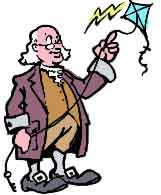Evidence for the Structure of Atoms
 How do we know what the structure of atoms is like?
How do we know what the structure of atoms is like?
 Our current picture of the atom wasn't created all at once; it was built up
and improved step by step based on experimental evidence and some extremely
clever insights.
Our current picture of the atom wasn't created all at once; it was built up
and improved step by step based on experimental evidence and some extremely
clever insights.
Some ancient Greek philosophers speculated that everything might be made of little chunks they called "atoms." The name comes from a Greek word meaning "uncuttable"; atoms were supposed to be unbreakable, the smallest possible units of anything.
| In later centuries, scientists more or less left the atom idea on the shelf, until the early nineteenth century, when the chemist John Dalton came out with an updated atomic theory of his own. |

|
This is the same John Dalton I mentioned in our discussion of atomic weight. As I said then, he and others had noticed that elements in chemical reactions combine in certain definite proportions; this, Dalton guessed, had to mean that the elements were made of tiny, unbreakable chunks that always stick together in the same ways--two hydrogen chunks plus an oxygen chunk always makes water, for example.
 So Dalton's guess was right.
So Dalton's guess was right.
 It was, and it wasn't.
The scientific world soon accepted that atoms did exist...but were they really
unbreakable?
It was, and it wasn't.
The scientific world soon accepted that atoms did exist...but were they really
unbreakable?
|
Meanwhile, a lot of apparently unrelated experiments about electricity had
been going on. By the nineteenth century, scientists knew a fair
amount about how electricity behaved--but what was it, exactly? Some
kind of fluid? Waves? A bunch of little particles?
|

|
To find out more about Thomson and his experiments, you can take a look at the following links:
 Life,
the Universe, and the Electron
Life,
the Universe, and the Electron
-
(The Science Museum, London, and the Institute of Physics)
-
(American Institute of Physics)






